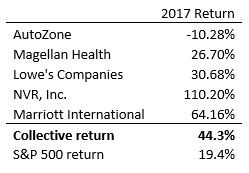‘The outlook for Aussie Equities is average.’
That’s according to fund manager Mark Landau.
Adding weight to these words is Landau’s track record.
He and his team at L1 Capital generated 30.5% returns (after fees) last year. And since inception (September 2014), they’re up 36.9%.
What’s incredible about these returns is how they came about.
L1 doesn’t hold many stocks. They don’t buy ‘the market’ and then adjust the weightings. They don’t buy large chucks of small-caps, either.
So how have they generated such great returns? By buying companies like Commonwealth Bank, ANZ Banking Group and Boral, at the right time.
When speaking at a JANA investor conference last week, Landau said he likes Boral, Seven Group, CIMIC, Lend Lease, Qantas and Star Entertainment.
‘Companies like Boral, Seven Group, CIMIC, Lend Lease are really well positioned,’ he said. They all stand to benefit from an infrastructure and tourism boom.
But Landau’s thematic style might not be for you.
How to achieve great returns
To achieve such returns, hours, weeks and months were spent to keep up to date on everything happening within the Aussie stock universe.
Not only has L1 had to buy undervalued companies. They’ve had to buy them at the right time. The latter is pretty much impossible to do over the long run. In fact, L1’s newly listed investment company proved that.
The Australian Financial Review writes:
‘…L1 shocked the market with the news that in just nine weeks since it hit the boards, and after more than three years of unbroken, peerless gains in their unlisted fund, the new long-short LIC (with an identical mandate) has torched a breathtaking 10 per cent of its net tangible asset value, or (a positively Blue Sky-esque) $133.7 million. In nine weeks! How does that even happen?
‘L1 blamed an “historical extreme” whereby growth companies (their OTT valuations seductive to shorts) are on a stubborn tear while out-of-fashion (or “value”) stocks are standing still.’
Basically, they’re saying that value investing is momentarily not working. Or it could be that their timing is off.
As I mentioned, it would be extremely tough to generate annual returns of 30% buying Bluechip’s, without a bit of help from time.
After all, the market is not completely efficient.
Market prices can be wrong for months, even years at a time. Over the long haul, however, cheap businesses with growing values tend to outperform.
But like I said, L1’s strategy might not be for you. You might not have the time, or willingness to come home after work and pour through swaths of data.
And that’s OK.
You don’t need to always be up to date on what’s happening to generate returns of 30% or more. That’s why today, I’m going to show you how to use your time effectively to try and find some of the very best stocks on the ASX. [openx slug=inpost]
How to find the best stocks with little effort
Even though Landau believes Aussie equities are ‘average’ right now, it doesn’t mean there aren’t opportunities. But how can you find the best ones without too much effort.
One way to cut down your search is to focus on characteristics that many rising stocks have.
Rising sales, earnings and cash flow. These are all qualities of successful companies, and thus successful stocks.
But not only are rising stocks backed by great businesses (which have the qualities above), they also tend to be cheap to begin with.
The problem is, stock prices don’t reflect what’s happened, but what could happen. So how can you determine if a company is cheap in a relatively short time?
It’s actually pretty hard to do.
A PE, forward PE an many other multiple, are poor indicators of cheapness. But a proxy like share buybacks could be the winning ticket.
You might have seen companies buy back shares before. In fact, right now, CSL Ltd [ASX:CSL] is doing exactly that.
The reason companies buy back their own stock is because management thinks the stock is cheap. Think of stock repurchases like you would any other project a business might undertake.
Only in this scenario, the project is to invest in themselves.
While earnings don’t increase on an absolute basis, they do increase, sometimes significantly, on a per share basis.
And by buying back shares, management improves per-share economics for shareholders.
To see how this works, take a look at these US stocks:
- AutoZone
- Magellan Health
- Lowe’s Companies
- NVR, Inc.
- Marriott International
All of these companies were aggressively buying back stock in 2017. And while all didn’t make gains that year, the average return comfortably beats that of the S&P 500.
 |
Of course, I’m not telling you to follow this method blindly. And I doubt you’ll see the same returns from similar stocks each year.
But looking at companies aggressively buying back stock is one way to narrow a universe into a manageable group, while also increasing your chances of finding winners.
Your friend,
Harje Ronngard





Harje Ronngard is one of the editors at Money Morning New Zealand. With an academic background in finance and investments, Harje knows how difficult investing is. He has worked with a range of assets classes, from futures to equities. But he’s found his niche in equity valuation. There are two questions Harje likes to ask of any investment. What is it worth? And how much does it cost? These two questions alone open up a world of investment opportunities which Harje shares with Money Morning New Zealand readers.